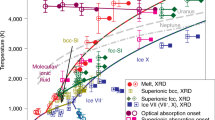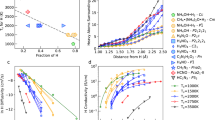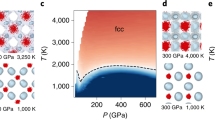Abstract
Superionic states are phases of matter that can simultaneously exhibit some of the properties of a liquid and of a solid. For example, in superionic ice, hydrogen atoms can move freely while oxygen atoms are fixed in their sublattice. ‘Superionicity’ has attracted much attention in both fundamental science and applications. Helium is the most inert element in nature and it is generally considered to be unreactive. Here, we use ab initio calculations to show that He and H2O can form stable compounds within a large pressure range that can exist even close to ambient pressure. Surprisingly, we find that they can form two previously unknown types of superionic state under high pressure and high temperature. In the first of these phases, the helium atoms exhibit liquid behaviour within a fixed ice-lattice framework. In the second phase, both helium and hydrogen atoms move in a liquid-like fashion within a fixed oxygen sublattice. As the He–O interaction is weaker than the H–O interaction, the helium atoms in these superionic states have larger diffusion coefficients and lower ‘melting’ temperatures than those of hydrogen, although helium is heavier than hydrogen. The insertion of helium atoms substantially decreases the pressure at which superionic states may be formed, compared to those in pure ice.
This is a preview of subscription content, access via your institution
Access options
Access Nature and 54 other Nature Portfolio journals
Get Nature+, our best-value online-access subscription
$29.99 / 30 days
cancel any time
Subscribe to this journal
Receive 12 print issues and online access
$209.00 per year
only $17.42 per issue
Buy this article
- Purchase on Springer Link
- Instant access to full article PDF
Prices may be subject to local taxes which are calculated during checkout





Similar content being viewed by others
Data availability
The data that support the plots within this paper and other findings of this study are available from the corresponding authors upon reasonable request.
References
Demontis, P., LeSar, R. & Klein, M. L. New high-pressure phases of ice. Phys. Rev. Lett. 60, 2284–2287 (1988).
Cavazzoni, C. et al. Superionic and metallic states of water and ammonia at giant planet conditions. Science 283, 44–46 (1999).
Yakushev, V., Postnov, V., Fortov, V. & Yakysheva, T. Electrical conductivity of water during quasi-isentropic compression to 130 GPa. J. Exp. Theor. Phys. 90, 617–622 (2000).
Chau, R., Mitchell, A., Minich, R. & Nellis, W. Electrical conductivity of water compressed dynamically to pressures of 70–180 GPa (0.7–1.8 Mbar). J. Chem. Phys. 114, 1361–1365 (2001).
Goncharov, A. F. et al. Dynamic ionization of water under extreme conditions. Phys. Rev. Lett. 94, 125508 (2005).
Goldman, N., Fried, L. E., Kuo, I.-F. W. & Mundy, C. J. Bonding in the superionic phase of water. Phys. Rev. Lett. 94, 217801 (2005).
French, M., Mattsson, T. R., Nettelmann, N. & Redmer, R. Equation of state and phase diagram of water at ultrahigh pressures as in planetary interiors. Phys. Rev. B 79, 054107 (2009).
Redmer, R., Mattsson, T. R., Nettelmann, N. & French, M. The phase diagram of water and the magnetic fields of Uranus and Neptune. Icarus 211, 798–803 (2011).
Ninet, S., Datchi, F. & Saitta, A. M. Proton disorder and superionicity in hot dense ammonia ice. Phys. Rev. Lett. 108, 165702 (2012).
Sugimura, E. et al. Experimental evidence of superionic conduction in H2O ice. J. Chem. Phys. 137, 194505 (2012).
Wilson, H. F., Wong, M. L. & Militzer, B. Superionic to superionic phase change in water: consequences for the interiors of Uranus and Neptune. Phys. Rev. Lett. 110, 151102 (2013).
Sun, J., Clark, B. K., Torquato, S. & Car, R. The phase diagram of high-pressure superionic ice. Nat. Commun. 6, 8156 (2015).
Bethkenhagen, M., Cebulla, D., Redmer, R. & Hamel, S. Superionic phases of the 1:1 water–ammonia mixture. J. Phys. Chem. A 119, 10582–10588 (2015).
French, M., Desjarlais, M. P. & Redmer, R. Ab initio calculation of thermodynamic potentials and entropies for superionic water. Phys. Rev. E 93, 022140 (2016).
Hernandez, J.-A. & Caracas, R. Superionic phase transitions in body-centered cubic H2O ice. Phys. Rev. Lett. 117, 135503 (2016).
Bethkenhagen, M. et al. Planetary ices and the linear mixing approximation. Astrophys. J. 848, 67 (2017).
Jiang, X., Wu, X., Zheng, Z., Huang, Y. & Zhao, J. Ionic and superionic phases in ammonia dihydrate NH3⋅H2O under high pressure. Phys. Rev. B 95, 144104 (2017).
Hernandez, J.-A. & Caracas, R. Proton dynamics and the phase diagram of dense water ice. J. Chem. Phys. 148, 214501 (2018).
Millot, M. et al. Experimental evidence for superionic water ice using shock compression. Nat. Phys. 14, 297–302 (2018).
Millot, M. et al. Nanosecond X-ray diffraction of shock-compressed superionic water ice. Nature 569, 251–255 (2019).
Kamaya, N. et al. A lithium superionic conductor. Nat. Mater. 10, 682–686 (2011).
Wang, X., Xiao, R., Li, H. & Chen, L. Oxysulfide LiAlSO: a lithium superionic conductor from first principles. Phys. Rev. Lett. 118, 195901 (2017).
He, X., Zhu, Y. & Mo, Y. Origin of fast ion diffusion in super-ionic conductors. Nat. Commun. 8, 15893 (2017).
Liu, H. et al. Copper ion liquid-like thermoelectrics. Nat. Mater. 11, 422 (2012).
Qiu, W. et al. Part-crystalline part-liquid state and rattling-like thermal damping in materials with chemical-bond hierarchy. Proc. Natl Acad. Sci. USA 111, 15031–15035 (2014).
Cazorla, C., Errandonea, D. & Sola, E. High-pressure phases, vibrational properties, and electronic structure of NeHe2 and ArHe2: a first-principles study. Phys. Rev. B 80, 064105 (2009).
Wang, Y., Zhang, J., Liu, H. & Yang, G. Prediction of the Xe–He binary phase diagram at high pressures. Chem. Phys. Lett. 640, 115–118 (2015).
Vos, W. L. et al. A high-pressure van der Waals compound in solid nitrogen–helium mixtures. Nature 358, 46 (1992).
Ninet, S., Weck, G., Loubeyre, P. & Datchi, F. Structural and vibrational properties of the van der Waals compound (N2)11He up to 135 GPa. Phys. Rev. B 83, 134107 (2011).
Dong, X. et al. A stable compound of helium and sodium at high pressure. Nat. Chem. 9, 440–445 (2017).
Monserrat, B., Martinez-Canales, M., Needs, R. J. & Pickard, C. J. Helium–iron compounds at terapascal pressures. Phys. Rev. Lett. 121, 015301 (2018).
Zhang, J. et al. Rare helium-bearing compound FeO2He stabilized at deep-earth conditions. Phys. Rev. Lett. 121, 255703 (2018).
Gao, H., Sun, J., Pickard, C. J. & Needs, R. J. Prediction of pressure-induced stabilization of noble-gas-atom compounds with alkali oxides and alkali sulfides. Phys. Rev. Mater. 3, 015002 (2019).
Liu, Z. et al. Reactivity of He with ionic compounds under high pressure. Nat. Commun. 9, 951 (2018).
Li, Y. et al. Route to high-energy density polymeric nitrogen t-N via He–N compounds. Nat. Commun. 9, 722 (2018).
Liu, H., Yao, Y. & Klug, D. D. Stable structures of He and H2O at high pressure. Phys. Rev. B 91, 014102 (2015).
Teeratchanan, P. & Hermann, A. Computational phase diagrams of noble gas hydrates under pressure. J. Chem. Phys. 143, 154507 (2015).
Bronstein, Y., Depondt, P., Finocchi, F. & Saitta, A. M. Quantum-driven phase transition in ice described via an efficient Langevin approach. Phys. Rev. B 89, 214101 (2014).
Hermann, A., Ashcroft, N. W. & Hoffmann, R. Isotopic differentiation and sublattice melting in dense dynamic ice. Phys. Rev. B 88, 214113 (2013).
Xia, K. et al. A novel superhard tungsten nitride predicted by machine-learning accelerated crystal structure search. Sci. Bull. 63, 817–824 (2018).
Pickard, C. J. & Needs, R. J. High-pressure phases of silane. Phys. Rev. Lett. 97, 045504 (2006).
Pickard, C. J. & Needs, R. J. Ab initio random structure searching. J. Phys. Condens. Matter 23, 053201 (2011).
Kresse, G. & Furthmüller, J. Efficient iterative schemes for ab initio total-energy calculations using a plane-wave basis set. Phys. Rev. B 54, 11169–11186 (1996).
Perdew, J. P. et al. Atoms, molecules, solids, and surfaces: applications of the generalized gradient approximation for exchange and correlation. Phys. Rev. B 46, 6671–6687 (1992).
Clark, S. J. et al. First principles methods using CASTEP. Z. Kristallogr. Cryst. Mater. 220, 567–570 (2009).
Grimme, S., Antony, J., Ehrlich, S. & Krieg, H. A consistent and accurate ab initio parametrization of density functional dispersion correction (DFT-D) for the 94 elements H-Pu. J. Chem. Phys. 132, 154104 (2010).
Klimeš, J., Bowler, D. R. & Michaelides, A. Chemical accuracy for the van der Waals density functional. J. Phys. Condens. Matter 22, 022201 (2009).
Hamada, I. van der Waals density functional made accurate. Phys. Rev. B 89, 121103 (2014).
Togo, A. & Tanaka, I. First principles phonon calculations in materials science. Scr. Mater. 108, 1–5 (2015).
Acknowledgements
J.S. gratefully acknowledges financial support from the MOST of China (grant nos. 2016YFA0300404 and 2015CB921202), the National Natural Science Foundation of China (grant nos. 11574133 and 11834006), the NSF of Jiangsu Province (grant no. BK20150012), the Science Challenge Project (no. TZ2016001), and the Fundamental Research Funds for the Central Universities and Special Program for Applied Research on Super Computation of the NSFC-Guangdong Joint Fund (the 2nd phase) under grant no. U1501501. C.J.P. and R.J.N. acknowledge financial support from the Engineering and Physical Sciences Research Council (EPSRC) of the UK under grants [EP/G007489/2] (C.J.P.) and [EP/P034616/1] (R.J.N.). C.J.P. also acknowledges financial support from the EPSRC and the Royal Society through a Royal Society Wolfson Research Merit award. The calculations were carried out using supercomputers at the High Performance Computing Center of Collaborative Innovation Center of Advanced Microstructures, the high-performance supercomputing centre of Nanjing University, ‘Tianhe-2’ at NSCC-Guangzhou and the CSD3 Peta4 CPU/KNL machine at the University of Cambridge.
Author information
Authors and Affiliations
Contributions
J.S. conceived the project. J.S. and H.-T.W. led the project. C.L., H.G., Y.W. and C.J.P. performed the calculations. C.L., H.G., C.J.P. and J.S. analysed the data. C.L., J.S., R.J.N., H.-T.W. and D.X. wrote the manuscript. All authors discussed the results and commented on the manuscript.
Corresponding authors
Ethics declarations
Competing interests
C.J.P. is an author of the CASTEP code, and receives royalty payments from its commercial sales by Dassault Systèmes.
Additional information
Peer review information: Nature Physics thanks Marius Millot and Ronald Redmer for their contribution to the peer review of this work.
Publisher’s note: Springer Nature remains neutral with regard to jurisdictional claims in published maps and institutional affiliations.
Supplementary information
Supplementary Information
Supplementary Figs. 1–8 and Tables 1–3.
Rights and permissions
About this article
Cite this article
Liu, C., Gao, H., Wang, Y. et al. Multiple superionic states in helium–water compounds. Nat. Phys. 15, 1065–1070 (2019). https://doi.org/10.1038/s41567-019-0568-7
Received:
Accepted:
Published:
Issue Date:
DOI: https://doi.org/10.1038/s41567-019-0568-7
This article is cited by
-
Rich proton dynamics and phase behaviours of nanoconfined ices
Nature Physics (2024)
-
Magnesium oxide-water compounds at megabar pressure and implications on planetary interiors
Nature Communications (2023)
-
Double superionicity in icy compounds at planetary interior conditions
Nature Communications (2023)
-
Critical topology and pressure-induced superconductivity in the van der Waals compound AuTe2Br
npj Quantum Materials (2022)
-
Liquid-like atoms in dense-packed solid glasses
Nature Materials (2022)



